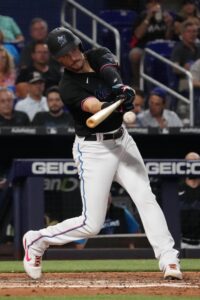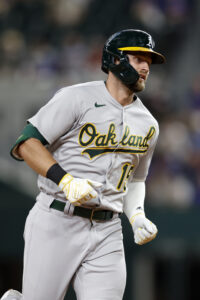The lingering Carlos Correa saga hangs over the free agency market, but beyond him the bulk of the free agents have found new homes for the 2023 season and beyond. While we won’t be seeing any monster deals from here, there are still a handful of players that could still have a positive impact on a new team. With that in mind, let’s take a look at the best (in this writer’s view anyway) remaining free agents at each position.
For a full list of the remaining free agents, go here.
Starting Pitcher: Johnny Cueto: 158 1/3 innings pitched, 3.35 ERA, 5.8 SO/9, 1.9 BB/9. Cueto enjoyed something of a resurgence last year for the White Sox, putting together his best campaign since 2016. His strikeout rate declined considerably but he offset that by displaying some of the best control of his career. He’ll turn 37 in February, so likely will only command a one-year deal but teams in need of a veteran arm to stabilize the backend of the rotation could certainly do worse than adding Cueto. The Padres, Marlins, Blue Jays and Reds have all had reported interest in the veteran right-hander at various stages of the off-season, while teams like the Angels have shown recent interest in adding another starter.
Relief Pitcher: Andrew Chafin: 57 1/3 IP, 2.83 ERA, 10.5 SO/9, 3.0 BB/9. Chafin’s been a quality left-handed reliever for the past few seasons now, the last of which came with the Tigers. He’s effective against both left and right-handed hitters, and should fit in as a late-inning arm wherever he winds up landing. Control was an issue earlier in his career, but he seems to have tidied that up and posted a mark below 8% for the second-straight season. That figure came with a quality 27.6% strikeout rate. After declining a $6.5MM option on his contract with the Tigers, he should be able to top that on the open market on a multi-year deal.
Catcher: Gary Sanchez: 471 plate appearances, .205/.282/.377, 16 home runs. The Yankees flipped Sanchez to Twins last winter after growing frustrated with his performance over the previous few seasons. Sanchez undoubtedly has talent, as evidenced by the 53 home runs and 143 wRC+ he compiled between 2016-17. He’s not come close to replicating that in the years since, slashing .202/.295/.427 for a below-average wRC+ of 96 between 2018-22. Sanchez has never been regarded as one of the top defensive catchers, but did post his best framing numbers per Fangraphs’ metric since 2018, and gave up the fewest wild pitches of his career (excluding the shortened 2020 season and 2016, when he didn’t play a full year). While a number of teams have filled their vacancy at catcher, the likes of the Red Sox, Tigers and Marlins could be among the teams interested.
First base: Trey Mancini: 587 PA, .239/.319/.391, 18 HR. Mancini split time between the Orioles and Astros in 2022, putting together a solid enough campaign at the plate. His 104 wRC+ in the past two seasons indicates he’s just four percent above the league average at the plate. For a first base/corner outfielder that’s unlikely to command a significant guarantee in free agency, but Mancini could still land a multi-year guarantee. There’s certainly an argument to be made that Mancini belongs in that outfield group of such an article, but any acquiring team would surely have him splitting time between first base and the outfield. Mancini was worth 2 Outs Above Average in 323 innings at first in 2022, the best mark of any of the positions he played.
Second base: Josh Harrison: 425 PA, .256/.317/.370, 7 HR. The 35-year-old Harrison recovered from a slow start to finish with a respectable season for the White Sox, finishing with a slightly below average 98 wRC+. That came after he was hitting just .167/.248/.255 on June 2. He doesn’t offer much in the way of power, but he provides a solid contact bat who can play all over the infield. Harrison logged most of his defensive time at second base, where he was worth 3 Defensive Runs Saved. He was also worth 3 DRS at third base, and can fill in at short and the corner outfield spots at a pinch. Teams in need of a veteran utility player could do worse than adding Harrison on a one-year deal.
Shortstop: Elvis Andrus: 577 PA, .249/.303/.404, 17 HR. Andrus started the year in Oakland, but was released in August and finished the season with the White Sox. The 34-year-old has a bit of pop in his bat, and grades out well defensively at shortstop, where he was worth 3 Outs Above Average in 2022. He may very well be the best infielder left on the open market, yet it’s been a quiet winter for Andrus, with little reported movement in his market. Obviously Correa has not officially signed a contract, but for the purposes of this article we’ll assume he’s heading to the Mets in which case Andrus would be the next best option for teams on the hunt for a shortstop.
Third base: Brian Anderson: 383 PA, .222/.311/.346, 8 HR. Anderson put up the worst offensive numbers of his five full seasons with the Marlins in 2022, finishing up with a 90 wRC+. That was the second-straight season of offensive decline for the 29-year-old, who put up a 115 wRC+ between 2018-20. He’s split time between third base and right field in recent times, grading out well in both until 2022. Last year, he was worth -4 DRS after picking up 12 DRS over the previous three seasons at the hot corner. The decline was enough for the Marlins to non-tender him this winter ahead of his final year of arbitration, but he could make sense as a buy-low bounceback candidate for any number of teams.
Left/Right field: Jurickson Profar: 658 PA, .243/.331/.391, 15 HR. Profar is arguably the top remaining free agent available. The 29-year-old (30 in February) puts the ball in play plenty, as evidenced by his quality 15.7% strikeout rate. He also takes plenty of walks and has a bit of pop in the bat. A former middle infielder, the Padres played him exclusively in left last year and he picked up 2 Defensive Runs Saved. He turned down an $7.5MM in favor of a $1MM buyout this winter to hit the open market in search of a multi-year deal. The Rangers and Yankees make sense as teams looking for left field help, while the Marlins and Rockies could also make sense.
Center field: Albert Almora: 235 PA, .223/.282/.349, 5 HR. The center field market was not deep to begin with, and is now largely limited to glove first options. Almora doesn’t pose much of a threat with the bat, as evidenced by his 71 wRC+, but he was worth 8 Defensive Runs Saved in the outfield for the Reds, with four of those coming in center field. He’s unlikely to be a starting option for teams but would make sense as a glove-first bench option.
Designated Hitter: Nelson Cruz: 507 PA, .234/.313/.337, 10 HR. After a number of years of elite production at the plate, 2022 was the first below average year for Cruz since 2007 (per wRC+). He’s now 42, so betting on him bouncing back is a risky one, but he mashed 89 home runs and compiled a 146 wRC+ between 2019-21 so it’s not like this has been a steady decline over a number of years. With that being said, he hasn’t played the field at all since 2018 so is exclusively limited to DH duties. It was reported a few days ago that he has received offers for the 2023 season though, so it seems he will be back for a 19th big league season.


